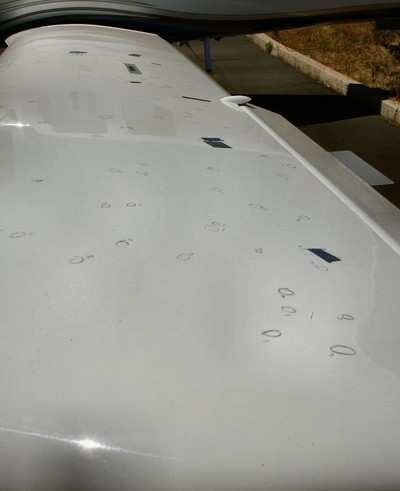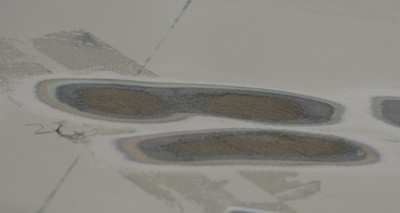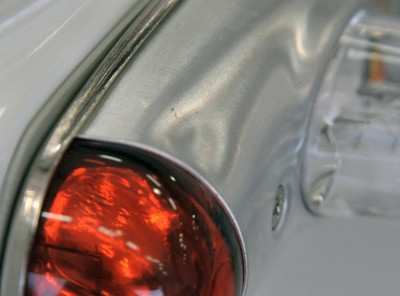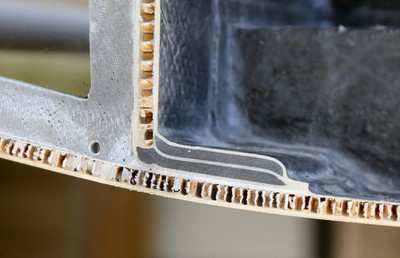Repeat After Us... It Could Have Been MUCH Worse
 ANN Note:
Several of the pictures accompanying this article have been
"photoshopped" in order to make the damage more visible to our
readers, via extra contrast, sharpening or highlighting... this
process does not minimize the nature of the damage, but in fact may
tend to make the actual damage appear worse than it shows to the
naked eye. -- Jim Campbell, ANN
Editor-In-Chief
ANN Note:
Several of the pictures accompanying this article have been
"photoshopped" in order to make the damage more visible to our
readers, via extra contrast, sharpening or highlighting... this
process does not minimize the nature of the damage, but in fact may
tend to make the actual damage appear worse than it shows to the
naked eye. -- Jim Campbell, ANN
Editor-In-Chief
While the rumors have been running hot and heavy about the
damage suffered by over 60 aircraft at the Columbia Aircraft
factory in Bend, OR, an onsite inspection by ANN indicates that the
damage may be far less extensive than feared.
ANN had the opportunity to inspect dozens of aircraft that were
involved in the freak June 12th storm that dumped golf ball sized
hail on more than 60 aircraft that were being prepped for
delivery.
In an exclusive June 23rd ANN story on the
storm, Columbia Aircraft CEO Bing Lantis reported that
he missed the missed the storm, personally... since he was visiting
the Atlanta offices of Columbia's lead insurance provider, AIG.

"I was giving a presentation on what a safe risk we are," said
Lantis ruefully. "I'm told the hail came down suddenly... it was
not a hot day, not the kind of day you'd associate with a storm at
all."
Lantis adds workers only had time to pull one plane off the ramp
before the hailstones came... and once the hail came, it pelted the
ramp outside the factory for 12 minutes.
"Hailstones were hitting the runway and taxiway, and bouncing 10
feet in the air," Lantis says workers told him.

Lantis told ANN that the curved fuselages of the aircraft seemed
to have withstood the hail attack well... in fact, for the first
two days after the storm, it appeared there was no damage to the
planes at all.
Upon further inspection, however, Lantis said "you can see marks
where hailstones impacted the surfaces," when the light is right.
The marks appear in the plane's normally glossy paint, he says --
with no apparent damage to the composite skin.
ANN was given unrestricted access to the ramp where the damaged
aircraft awaited final inspection and repair, and walked through
the rows of aircraft, each of them featuring small black circles
(made by Columbia staff) indicating areas of hail impact revealed
by intensive inspection after Mother Nature had done her worst.

While the FAA and Columbia's insurers are working to come up
with a solution that not only makes sure that whatever damage that
may have been done is fixed, and gets these aircraft into the hands
of owners ASAP; the owners have apparently become just as concerned
about the delay in getting their aircraft as the damage from the
hail, as word reaches them that the structures are holding up well
to the scrutiny lavished upon them thus far.
Please note that ANN's inspection was admittedly cursory and not
performed by an A&P or other qualified aircraft technician
(though we have consulted with a number of qualified techs
about the issue), we had the chance to look over dozens of
aircraft, most of which were covered with countless small grease
pencil circles where inspectors indicated that hail had hit.
Our visual inspection, outside on a sunny afternoon revealed
that of over 2000 such circles -- inspected both directly and
obliquely (from an angle by which any potential depression was more
likely to be discerned), barely a dozen showed any actual
impact depression, cracking or other evidence of external
stigmata.
In hundreds of impacts inspected by ANN, under close
scrutiny and the use of magnifying lenses, areas circled by
Columbia's inspectors showed no visibly discernible evidence of
damage. Even attempts to feel for depressions or to "tap" the
structure to listen for evidence of a change in tone, a lack of
aural continuity, or other overt response revealed nothing we could
point to as out of the ordinary.

In those rare areas where cracking or paint penetration was
actually evident, the damaged area was taped over to prevent
moisture or other contamination from getting under the outside
paint layer and further exacerbating the potential for damage. From
what we have seen, Columbia's tech crews have done an amazing job
of not only inspecting each aircraft, but containing the potential
for further harm.
On several aircraft that were already being sanded/stripped of
paint and primer, close visual inspection of the structure and the
underlying composite material/fabric has revealed no breaks in the
actual composite materials -- and are (thus far) requiring little
more than refinishing (shown below, in process) to restore the
aircraft to flying status.

The most visible evidence of damage to the aircraft has
apparently occurred to the few metallic (and some plastic)
assemblies attached to the aircraft. In several cases, the metallic
housings surrounding the wingtip lights took hits that damaged the
aluminum shell, while several of the static wicks attached to the
trailing edges of the ailerons were hit and actually severed or
bent the insulated cables that comprise the internal portion of the
assembly.

A few of the protective lens covers that protect the landing
lights were also damaged.

In many cases, the lack of damage has made a difficult task all
that more rigorous. "Just because you can't see the damage is no
reason to take for granted that there is none... we're going over
every airplane very carefully," noted Columbia Aircraft's VP of
Customer Care, David McRae.

As an example of the kind of damage that Columbia staffers had
once feared would occur as the storm was underway, McRae showed ANN
several staff cars in the company parking lot, that had been hit by
the hail... some of which suffered thousands of dollars of damage
(and indeed, a local car dealer is reportedly having to total
millions of dollars of vehicles that were caught in the storm). In
comparison to a horribly pitted BMW, the Columbia birds looked like
they came off very well, indeed.
Columbia staffers are becoming more and more impressed, as the
inspections progress, of the ability of modern composite structures
to take the impacts of intense hail bombardment with little or no
permanent damage. Tests conducted with sample structures exposed to
impacts that were at least twice that of those estimated to have
occurred in the June 12th storm, have also shown no permanent
physical damage to the structures, and have further confirmed the
resilience of the current crop of composite aircraft designs. In
the coming weeks, Columbia's inspections, the FAA's judgement and
other engineering oversight is going to provide some amazing
information about the nature of composite structures (normal wing
Cross-section shown below) when exposed to such types of impact
damage.

ANN as been promised to be kept up to date of the progress made
by Columbia in bringing the damaged aircraft to a deliverable
condition (and indeed, Columbia has been more than forthcoming
about the matter as the information became known). Columbia CEO
Bing Lantis has been adamant about making sure that customers
picking up new aircraft be able to have complete confidence in the
birds, something that has been clouded by a rumor mill (often
associated with competitors unfortunately taking advantage of the
situation) that has greatly over-hyped the actual damage that was
done. In fact; as time goes on, Columbia is becoming more and more
impressed with what they are finding and the knowledge that they
are accumulating as a result.

"We have a unique situation," Lantis said, "because there's
never been a claim for hail damage on a Columbia -- and I would
guess that's probably pretty true of any other composite airplane.
It's a very durable material."
ANN will have more info on this story as it becomes
available.
 ANN's Daily Aero-Linx (04.15.24)
ANN's Daily Aero-Linx (04.15.24) Classic Aero-TV: 'No Other Options' -- The Israeli Air Force's Danny Shapira
Classic Aero-TV: 'No Other Options' -- The Israeli Air Force's Danny Shapira Aero-News: Quote of the Day (04.15.24)
Aero-News: Quote of the Day (04.15.24) Airborne 04.16.24: RV Update, Affordable Flying Expo, Diamond Lil
Airborne 04.16.24: RV Update, Affordable Flying Expo, Diamond Lil ANN's Daily Aero-Term (04.16.24): Chart Supplement US
ANN's Daily Aero-Term (04.16.24): Chart Supplement US













